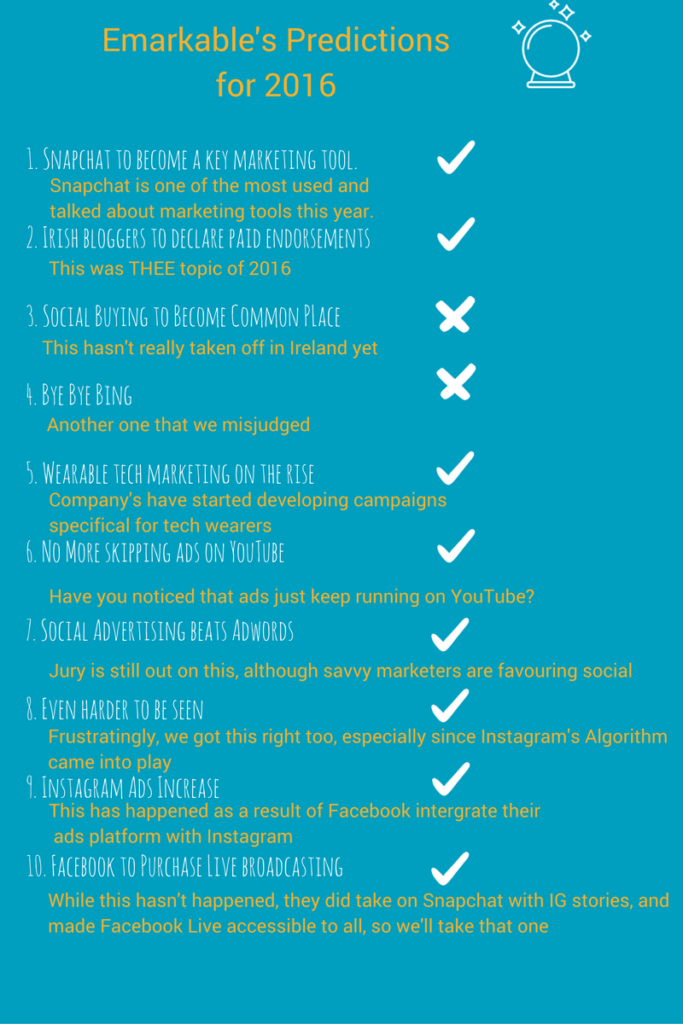Digital Marketing in 2017 – Claire’s Marketing Predictions
What will Digital Marketing look like in 2017?
Yes, year end is done and dusted and it’s time to think ahead to 2017; how are businesses going to drive traffic to their sites and drive their leads upwards? Last year we made some predictions as to how the digital land was going to lay in 2016, and we hit the nail on the head with quite a few of our predictions – quite the marketing Nostradamus, if I do say so myself! Before we move on to our predictions for next year, take a look below to see what we got right, and where we went wrong in our digital marketing predictions.
How did we fare in our 2016 predictions?

Moving swiftly on to the future, here is where we thing Digital Marketing is going to go in 2017.
1. Chatbots and AI will become commonplace
Chatbots, like the ones created by Freshdesk will become more and more common in business. While Irish businesses tend to be a few steps behind the rest of the world, don’t be surprised if you see some companies who create these kinds of bots moving in on the Irish enterprise market. These will be particularly useful and dominant in tech based businesses.
2. Native Marketing will rise even more
Native advertising is content that “hides” an advertisement. Think of the advertorials you might see in a glossy magazine. This ties in with the phenomenon of influencer marketing that exploded in 2016, and we are going to see more of it. With “Influencer Agencies” becoming a familiar business model, and with people hanging on the every word of well known names and faces, don’t be surprised if you see more bloggers, social media personalities and media outlets including more paid for content.
3. Interactive Tools and Gamification
Internet users are becoming much more pedantic about what they read and consume online. Interactive tools, games and quizzes are becoming much more popular forms of content and this trend is set to increase. Keep an eye out for companies incorporating games in particular into their social media marketing.
4. Better Data
Data online leaves most marketers wanting, particularly on Facebook, Instagram and LinkedIn. In 2017, we think the insights and data made available on Social Platforms will become even more relevant and will make it easier for marketers to report on and plan for marketing activities and campaigns. What insights would we like to see? Well, on Instagram it would be helpful to have access to data on a desktop computer, not just on mobile. It would also be beneficial to be able to view stats post by post, like we can with Facebook. Speaking of Facebook, we’d like to be able to see where our likes came from – did they like a post then like the page, did they search for our page and like it, or did they click on an ad or page recommendation? When it comes to Google Analytics, we’d like to see “not provided” disappear from our search query list. With recent changes to Google’s policies, we can’t see what people are searching if they are logged into a Google device or account- problematic to say the least. Hopefully this will be rectified in 2017.

An accurate representation of Claire predicting the future of marketing
5. Community makes a comeback
Before Social Media was really a thing, communities were king. We think that in 2017 Digital Marketing will edge more towards this format. While the likes of Boards.ie doesn’t have the same impact or pull as it used to, Tumblr and Reddit still thrive on the community format. Whether it’s setting up Instagram Pods, encouraging user generated content, or something as simple as having Facebook groups, community is defininitely going to make a comeback.
6. Algorithms for Twitter
We’ve been threatened with this so many times, but in 2017, we think it’s going to happen. Twitter will see how much revenue Facebook has gotten by essentially forcing businesses to pay to be seen, and they will make it difficult for Tweeters to appear on their followers’ feeds. Bonus prediction: they’ll go back on it. People will complain, ads won’t be clicked and Twitter will realise it’s the “live” aspect that drives people to Twitter.
7. Pop-ups will be killed off
Google have already introduced a penalty for websites that have pop ups on their site, but that’s not going to kill it off. As information consumers we are getting less patient when it comes to getting to the content we want, and even less tolerant of invasive ads (that’s why Native Advertising works so well). This will drive bounce rates up, and when marketers figure out the issue, we’ll say “bye bye” to pop-ups.
8. Content Marketing will become a sellers market
Content is a cornerstone of any marketing campaign, whether that’s emails, graphics, blog posts and so on. More and more companies are realising this, and eventually it’s going to become a sellers’ market. Content creators will pretty much be able to name their price to companies who want impactful and well done content.
9. Snapchat Analytics
The semi-wild card prediction – we think, or hope, rather, that Snapchat create analytics. In order to do this, though, that might mean switching to a business profile, which could also mean you are not likely to come up at the top of Snapchat users’ feed. We’re not sure which is more valuable right now. We think this is an eventual given, however, because there is no way to really prove your worth on Snapchat. We think publicisits, PRs and brand managers will need to see more figures, and Snapchat will probably deliver.
What predictions have you got based on what you’ve seen in your industry? Follow us on Twitter to join in on the discussion. If you need the help of forward thinking marketing consultants, contact us to discuss how we can help you.


